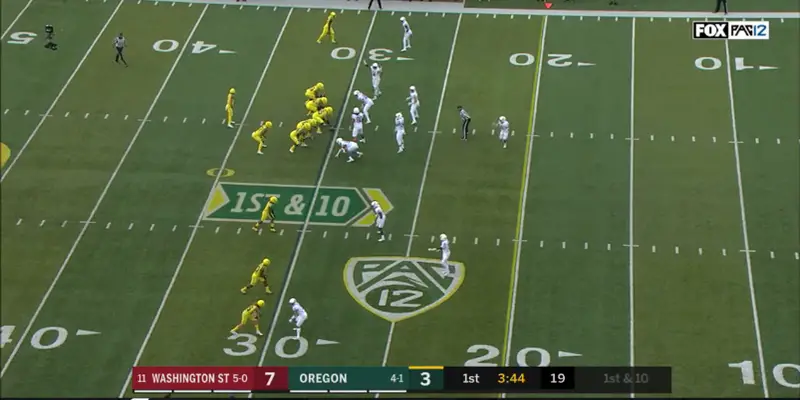Welcome to the fifth installment of X’s vs. O’s. In this series, we will analyze how Oregon utilizes different schemes and techniques to attack and defend the opposition.
Today we will be looking at a classic example of a coverage bust from last week’s encounter between the Ducks and the Washington State Cougars (WSU). This play is a fantastic example of the Oregon staff dialing up the perfect playcall for the situation.
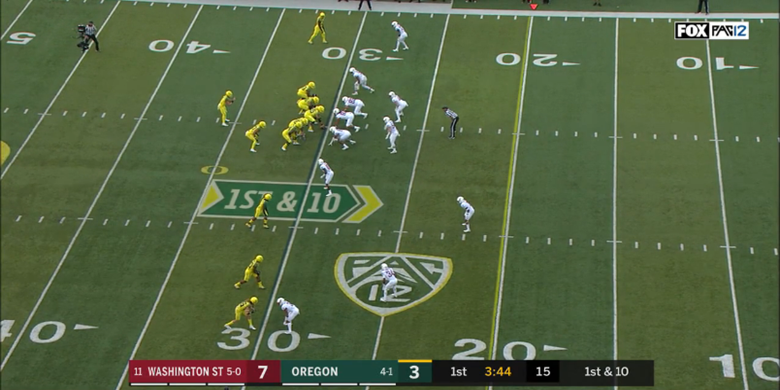
Defensive Alignment Prior To Jet Motion
On first-and-ten, we find Oregon in the Green Zone. The Green Zone is defined as the 40-yard line to the 20-yard line on the opponent’s side of the field (plus territory.) This is the perfect down and distance for a shot play. Just as it sounds, a shot play is a scheme designed to create an explosive play down the field for the offense.
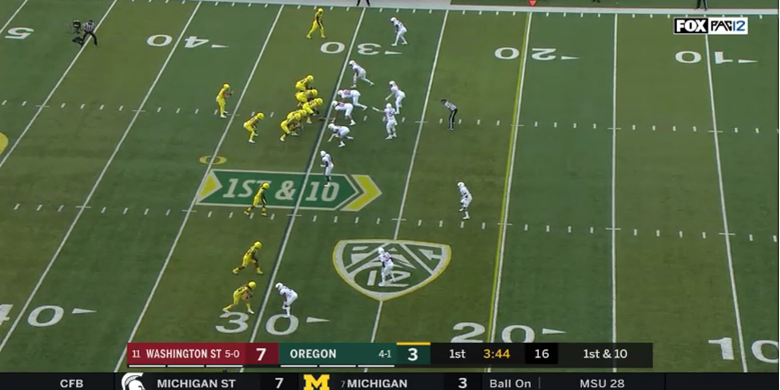
WSU Linebackers Communicate Before The Snap
Based on the pre-snap scramble, I’m not sure Washington State was prepared for this formation. Once the WR goes in motion, you can see the defenders continuing to communicate in the screenshot above. Given the result of the play, it’s clear they weren’t all on the same page.
A hallmark of Willie Taggart’s offense from the spring game onward has been the use of quads formations (4 receiving threats to one side). These formations limit the defense’s options and typically force defensive checks (audibles). These checks are usually very basic defenses. Through film study, they can easily be identified, and a plan of attack can be developed by the offensive staff.
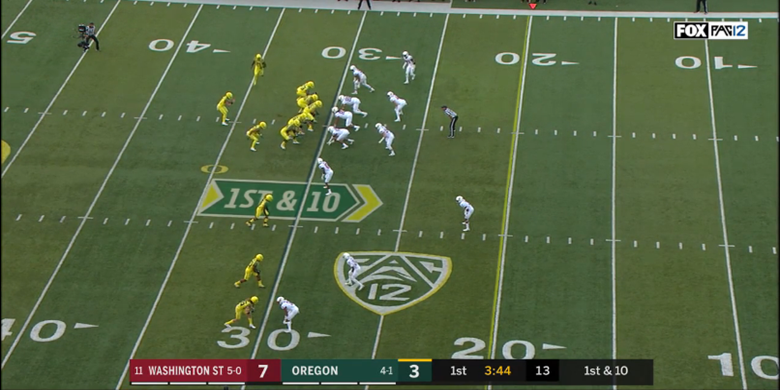
Defensive Alignment After Jet Motion
Above we see the final defensive alignment after the receiver goes in motion and just before the snap. Take special note of the fact that there are no safeties aligned deep in this defense.
There is a slight possibility of a disguised or trap coverage due to the depth and alignment of the Safety over the S3 receiver. The Safety could rotate to the deep half, while the Apex defender (labeled “A” in all diagrams below) could use a “slice” technique to guard the S3 in man coverage.
However, this is unlikely since the cornerback over S2 is playing with outside leverage. In this hypothetical 2 Man Under scenario, he would need to be playing with inside leverage like the rest of the men in coverage.
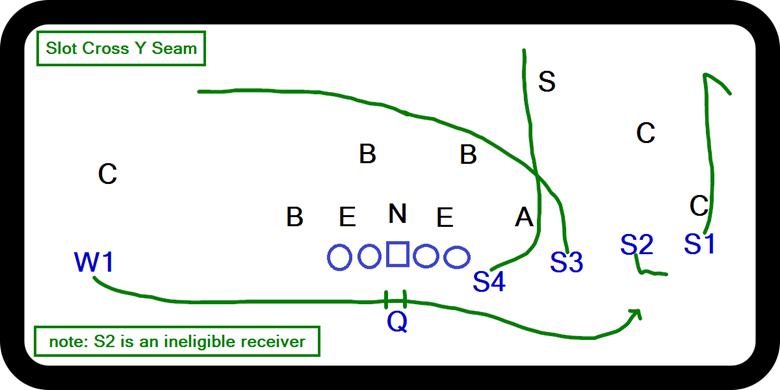
Slot Cross Y Seam
In the above diagram, you can see the route combination Oregon employed. This concept has spread like wildfire through the college ranks in recent years as split field coverage checks in response to trips (3 WRs to one side) and quads (4 WRs to one side) formations have become the norm.
This concept stresses the defender responsible for the vertical of the #3 receiver (S3). By sending S3 on an intermediate crossing pattern and sending another receiving threat up the seam, the defender is placed in a bind. This classic two-on-one scenario demands proper technique from this defender as well as disciplined play from the underneath defenders as the route concept develops.
And while this is the play’s primary design, it is a versatile concept that can be effective against other types of zone and man coverages. Due to the fact that the routes require time to develop, and to create more space for the crossing route, the concept is typically attached to a play action fake (as it is in our example).
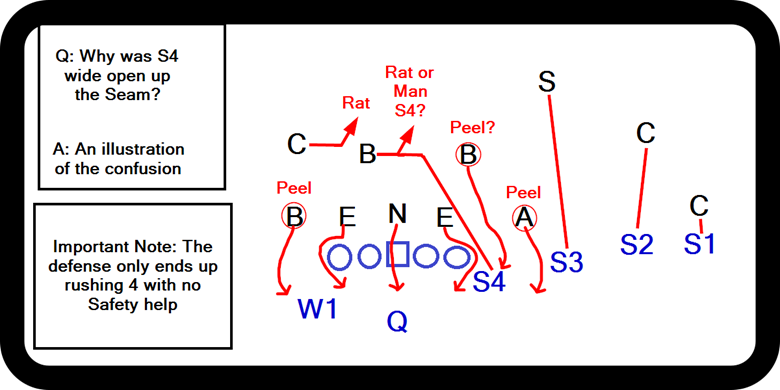
Illustrating The Defensive Confusion
The first thing that caught my eye on this play was the fact that WSU only rushed four. With no safety deep you can usually expect one of two things. Either an aggressive man blitz or a coverage designed to give this impression before dropping seven or eight into coverage.
Based on the film, I believe this was meant to be a man blitz scheme, with the defense bringing at least five defenders on the pass rush. The next two diagrams (directly below) show two basic checks WSU could have used in response to the Jet motion.
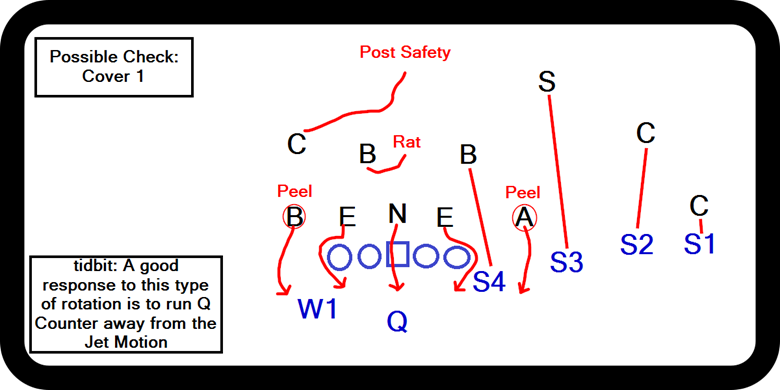
A Possible Check: Cover 1
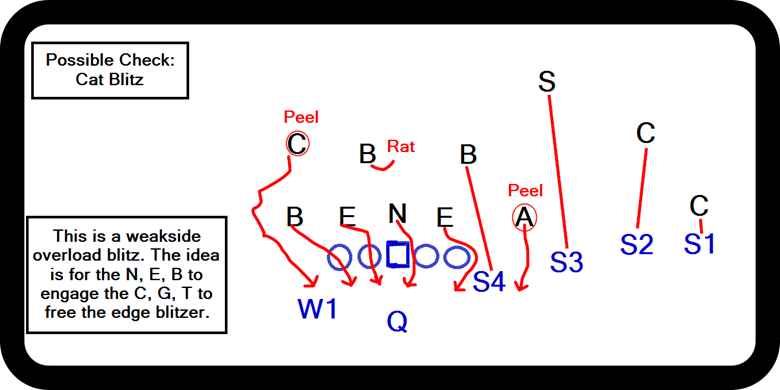
A Possible Check: Cat Blitz
I’m not suggesting that Oregon would not have had success on this play against these alternative defensive schemes, but WSU could have been in a better position to defend this well-designed, well-executed scheme from the Ducks, had they checked to one of the above man coverage options.
The aggressive Cat Blitz (above) is especially well-suited to disrupt a play that needs time to develop. The defense is practically guaranteed a free rusher against this empty pass protection scheme. Some defensive coordinators will even specifically gameplan blitzes like this to be mixed in with their base checks, just to keep the offense on its toes and hopefully force a negative play.
Nevertheless, this play highlights how Taggart’s offense employs unique formations that test defenders’ discipline and communication skills in a high pressure environment. Not only is this a quads formation, but the jet motion adds yet another element the defense must respect. Motion from the offense usually requires and/or elicits a response from the defense.
Anytime the offense can hear the gears turning in the heads of the defenders, it has gained an edge. Football is an instinctual game; once you start “thinking” instead of reacting, you’re at a disadvantage as a football player. As a result, the game can, and often is, decided before the kickoff. It requires intense preparation to play sound defense.
The best defenses are the ones that make the least amount of mental errors, and understand the how and why behind all the window dressing offenses use to create hesitation and confusion.
This article is a different type of analysis and format than the previous X’s vs. O’s entries. Please let me know what you think of this “picture book” format below in the comments section. Thank you for taking the time to join me as we study the new Oregon offensive system here at FishDuck.com.
Zach Pierson
Birmingham, Alabama
Top Photo from Video
Zach enjoys dissecting football gameplans and schemes from the confines of his home office on the outskirts of Birmingham, Alabama. His goal is to provide breakdowns that shed light on the intricacies of football, using simple, easy-to-understand language.

